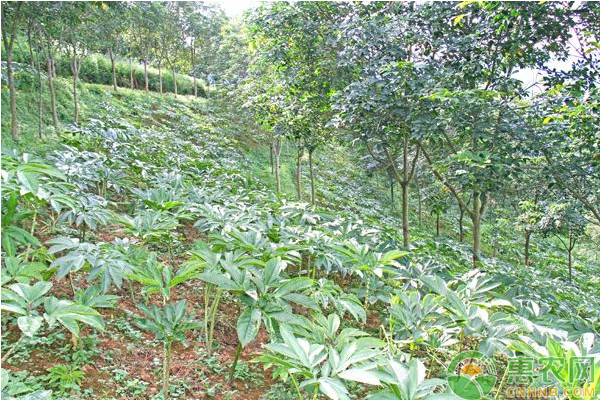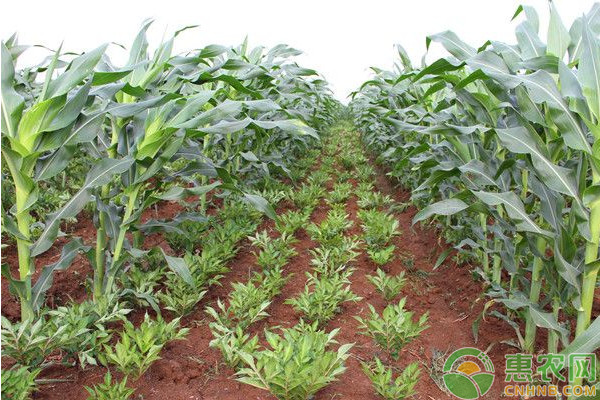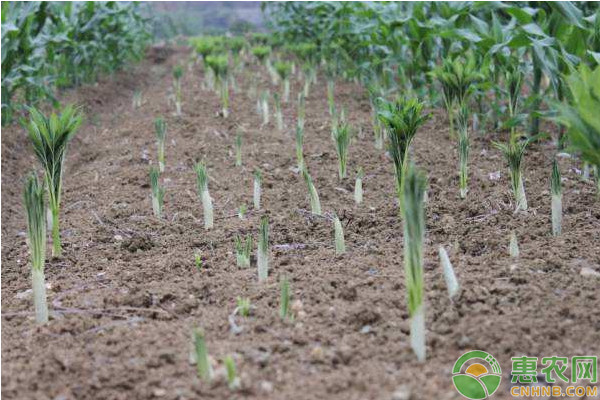There are 26 varieties of konjac in China. There are 6 varieties of konjac, white konjac, konjac, Dongchuan konjac, sparse konjac and scorpion konjac. Among them, the flower konjac, white konjac is the main cultivar in the southwest. Let's talk about the high-yield cultivation techniques of Konjac. 1 konjac cultivation significance Konjac tubers contain starch, protein, pectin, fat, glucomannan, vitamin A and vitamin B, and biosaponin. The maximum consumption is edible. It is recognized by the United Nations Health Organization as one of the top ten health foods because it promotes the unique effects of gastrointestinal motility and cholesterol lowering. Japan and South Korea are the world's largest konjac food consumers, and China's consumption has also increased year by year. According to the survey statistics, from 1984 to 2016, 32 years have been selling well, and the average price per kg has increased from 0.50 yuan to 5.20 yuan. Chengkou is an advantageous area for the production of Konjac. In 2016, the planting area was 0.27 million hm2, and the annual output value was 80 million yuan. The flower konjac was promoted. The konjac production will be a sunrise industry for the sustainable development of agricultural and rural economy. 2 Konjac growth and development characteristics The konjac originated from the forests of India and Southeast Asia, and evolved into a wild and semi-shadowing nature: hi warm but fear of high temperature, like wet and fear of water stains, like weak light and strong light, like soil loose and fear of soily and heavy knot. Therefore, it is the theme of konjac production to create a suitable environment for konjac, ensure normal growth and development, inhibit disease occurrence, and promote stable yield and high yield. The specific requirements for konjac growth and development on light, temperature, humidity, soil texture, nutrient and soil pH are as follows: 2.1 lighting Konjac needs a semi-shade environment, which requires weak sunshine intensity. The suitable light intensity for the development of the aboveground part is 1/3 of sunlight. The roots need dark light and are most afraid of direct sunlight. 2.2 Temperature During the growth period of konjac, the temperature is required to be 15~30°C. 15~20°C in seedling stage is conducive to growth, and 20~30°C is conducive to tuber swelling. In the early spring, the temperature starts at 12 °C, and the germination starts at 15 °C. The growth is inhibited at more than 35 °C. After the winter, it is lower than 12 °C. The upper part of the ground is naturally lodging. The dormant period can withstand minus 5 °C, and the underground tuber is less than minus 8 °C. . 2.3 Humidity The soil is required to be wet and well drained, the water content is 50%~65%, the relative humidity of the air is 55%~70%, and the annual rainfall is 1000~1500mm. 2.4 Soil texture Breathable, sandy soil with abundant organic matter, which is conducive to tuber swelling. 2.5 soil pH The soil pH is required to be 6.5 to 7.5. Among them: the suitable pH value of konjac is 6.5-7.0, and the suitable pH value of white konjac is 7.0-7.50. The acid soil konjac has a serious disease and low yield. 2.6 nutrients The requirements for konjac (large amount of elements) nitrogen, phosphorus and potassium are 6:1:8; spraying a small amount of copper fertilizer on the foliar surface can delay the senescence and drought resistance of the leaves; re-applying high-quality rotted livestock manure with straw slag fertilizer, Balance the supply of nutrients in the growth and development of konjac; single application of urea, the stems and leaves on the ground are prone to prolonged growth, underground tuber growth is often inhibited, resulting in uncoordinated growth and development, low yield, and often cause soft rot. 3 Konjac cultivation suitable area The growth and development characteristics of konjac are closely related to the environment in which they originate. Suitable for semi-shade, soil loose and moist, organic alkaline content rich in neutral alkaline soil. The altitude of 600 ~ 1 800 m is the suitable distribution area of ​​the flower konjac; the altitude below 600 m is the suitable cloth area of ​​the white konjac. The soil is thick and heavy, and it can be produced with heap slag fertilizer and humus soil, and semi-convex (stacking) planting. 4 Konjac suitable for sowing period Konjac is divided into winter sowing and spring sowing. Generally, more than 50 g of tubers are used for seed production, and commercial clams are produced, and rhizomes and small tubers are commonly used to expand and multiply. Warm areas should be sown in winter. When harvesting commercial tubers from November to December, they should be sown with smaller tubers, and the stalks will be wintering in the sowing area; in cold areas where the winter temperature is lower than -8 °C, suitable for spring sowing, planting with boudoir Stacked, stored with grass and wood smoke, and sown when the temperature rises above 12 °C per day. 5 Konjac cultivation requirements The konjac originated from the tropical forest. According to its characteristics, some farmers in Chengkou and Shaanxi province planted konjac under the forest and corn (high stalk) with konjac (dwarf stalk). The disease is light and productive, and promotes forestry and agriculture. The full coordination of food crops with cash crops, dwarf crops and high-stalk crops has significant economic benefits. 5.1 Konjac Intercropping Corn The ground width is 140cm, and the konjac and corn are planted in half, each covering a width of 70cm. Single-row and double-planting of maize, selecting varieties with tall plant shape, wide and long leaves, and hard stalks, planting more than 3,000 plants per 667 m2; konjac double-row planting, ridge cultivation, ridge height 30cm, 50g or more konjac species Planting 4 000 plants per 667 m2, planting large nests for fertilization, and applying 2 ~ 4 kg of high-quality rotted manure and slag mixed fertilizer in each litter. 5.2 cultivation of konjac under the forest With hedgehog, bamboo forest, mixed forest, can cover 80% of the sun-sparing forest, about 100g of konjac species, planting 2,500 plants per 667m2; 50g or so planting, planting 3,000 plants per 667m2. It is required to plant nests, each pit with a length, width and depth of 40 cm. The deciduous and organic topsoil will be concentrated in the small pit, and 3~4kg of high-quality rotted manure and straw residue will be applied; The buds were tilted and covered with soil for 10 cm. After sowing, the sulcus was 8 to 10 cm above the ground level. 6 Konjac Field Management 6.1 trenching and weeding After the konjac is planted, it is required to be surrounded by the planting area, and the ditch is deep and rich in water; when the konjac is emerged and in the middle of growth, artificially remove the weeds between the rows to promote ventilation and ventilation to inhibit weed competition. 6.2 Pest Control Konjac diseases mainly include soft rot (bacterial diseases) and chalk disease (fungal diseases). The first method is to plant healthy seeds, and the second is to use before sowing (72% 10 million units of agricultural streptomycin 800 times solution) Stem disinfection, the third is the rotation of the planting site, the fourth is to find the central disease plant early, concentrated and harmless treatment, and use 72% 10 million single agricultural streptomycin to root 40kg of water to prevent konjac soft rot; use Trichoderma Powder 500 ~ 100 times spray, to prevent konjac chalk disease; ground pests are mainly sweet potato larvae larvae, artificial killing; underground pests with enemy kill water to water. 7 Konjac Harvest and Storage 7.1 timely harvest When the color of the konjac leaves turns yellow, the petiole begins to fall to a suitable harvest period. Choose sunny days and harvest when the soil is dry. 7.2 Scientific storage Cold areas, broken tubers, tuber stems, stacked in a dry state, and smoked by wood fuel; in the warm zone, the tubers are stored in a moistened river with a clean river sand. 8 species of cockroach breeding Breeding seedlings under the forest, the disease is light and conducive to centralized management. Use whiplash (rhizo) and small tubers as propagation material. The planting area is deep-turned and applied to the farmyard manure, and the boxing is carried out. The width of the car is 2.5m wide, sowing in the horizontal or vertical direction. After sowing, it is covered with a thin layer of fine soil for moisturizing and water management. The above is the whole content of the key points of konjac cultivation technology. Welcome the konjac growers to come to Huinong.com to learn! Air Mattress,Inflatable Mattress,Air Bed Mattress,Air Mattress For Hospital Bed XIAMEN DORRELLA HEALTH TECHNOLOGY CO.,LTD , https://www.dinglimed.com


How does konjac planting achieve high yields? Konjac high quality and high yield cultivation technology